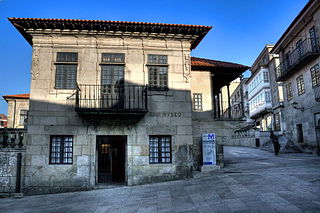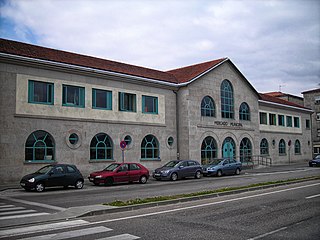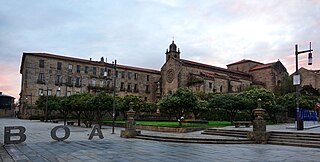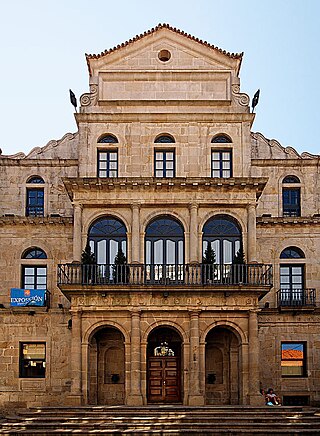
The Pontevedra City Hall in Pontevedra, Spain, is the seat of the city council of this Galician city. It is located at the eastern end of the Alameda de Pontevedra, on the edge of the old town. To the west it opens onto the pedestrian España Square.

The Palace of Mugartegui, or Palace of the Counts of Fefiñáns in Pontevedra, Spain, is a Baroque pazo dating from the 18th century. It currently houses the headquarters of the Regulatory Council of the Rías Baixas Designation of Origin.

The Palace of the Counts of Maceda, or Casa del Barón in Pontevedra, Spain, is an original Renaissance pazo dating from the 16th century. It is currently a four-star hotel belonging to the Paradores network.

The Pontevedra campus is one of three campuses that host the University of Vigo. It is located in the Spanish city of Pontevedra and offers undergraduate, postgraduate and doctoral studies in Social sciences, health sciences, arts, engineering and Sports.

The Praza da Ferrería is a large square located on the edge of the old town of Pontevedra (Spain), inside the old city walls. It is the main square of the old town and has an area of about 2,000 m2. It includes the small squares of the Estrella on the north side, the Orense square on the south side and the Casto Sampedro square on the east side, making a total of almost 5,000 m2.

The Casa de las Caras, also known as the Pazo de Barbeito y Padrón, is a 16th-century building in the heart of the historic centre of Pontevedra, Spain. It is known as the House of the Heads because of the Renaissance busts that decorate its façade on the upper floor.

The Provincial Savings Bank of Pontevedra was a Spanish financial institution based in the city of Pontevedra (Spain) dependent on the Provincial Council of Pontevedra, existing between 1930 and 2000.

The Pazo de García Flórez is an 18th-century baroque pazo located between Sarmiento Street and Plaza de la Leña in the city of Pontevedra, Spain, in the heart of the old town.

The Pazo de Castro Monteagudo, is an 18th-century baroque pazo in Pasantería Street, next to the Plaza de la Leña in the city of Pontevedra, Spain, in the heart of the old town.

The Central Market of Pontevedra is a covered market located in Pontevedra, Spain. It is located at the north-eastern edge of the historic centre, close to the Burgo Bridge. It overlooks the banks of the Lérez river and was inaugurated in 1948.

The paseo marítimo of Pontevedra is a pedestrian way along the seafront facing the ria of Pontevedra, in Pontevedra, Spain. This coastal public space is built in the urban and semi-urban area of the city and defines its encounter with the sea and the Lérez river.

The Plaza de la Pedreira or Plaza de Mugartegui is a square of medieval origin located in the northern part of the old town of Pontevedra (Spain).

The Convent of St. Francis is a Franciscan convent located in the city centre of Pontevedra (Spain), overlooking the Plaza de la Herrería. The Gothic church of San Francis is attached to the convent on the southeast side.

The Liceo Casino is a neoclassical building from 1878 located in the historic centre of Pontevedra, which houses the oldest cultural and leisure society in Pontevedra, Spain.

Curros Enríquez Square is a square of medieval origin located in the heart of the historic centre of Pontevedra (Spain), on the Portuguese pilgrimage way.

The Marquis of Riestra's mansion is an eclectic building with art Nouveau elements from the late 19th century located at 30 Michelena Street in Pontevedra, Spain. It currently houses the main central administrative services of the City Council of Pontevedra.

The Plaza del Muelle or Praza do Peirao is a square of medieval origin located at the northern edge of the historic centre of Pontevedra (Spain), very close to the Burgo Bridge and the old port neighbourhood A Moureira.

The Calle García Camba is a street in Pontevedra (Spain) located in the city centre, in the first urban expansion area. It is one of the main streets of Pontevedra.

The Calle de la Oliva is a street in Pontevedra (Spain) located in the city centre, on the edge of the old town. It is one of the main streets of Pontevedra and one of the most commercial.

The Casa de los Vaamonde, also known as the Old Carabineros Barracks, is a Gothic-Renaissance house located in the historic centre of the Spanish city of Pontevedra.


























